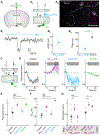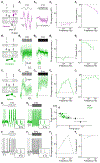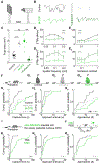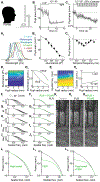A pupillary contrast response in mice and humans: Neural mechanisms and visual functions
- PMID: 38697114
- PMCID: PMC11257825
- DOI: 10.1016/j.neuron.2024.04.012
A pupillary contrast response in mice and humans: Neural mechanisms and visual functions
Abstract
In the pupillary light response (PLR), increases in ambient light constrict the pupil to dampen increases in retinal illuminance. Here, we report that the pupillary reflex arc implements a second input-output transformation; it senses temporal contrast to enhance spatial contrast in the retinal image and increase visual acuity. The pupillary contrast response (PCoR) is driven by rod photoreceptors via type 6 bipolar cells and M1 ganglion cells. Temporal contrast is transformed into sustained pupil constriction by the M1's conversion of excitatory input into spike output. Computational modeling explains how the PCoR shapes retinal images. Pupil constriction improves acuity in gaze stabilization and predation in mice. Humans exhibit a PCoR with similar tuning properties to mice, which interacts with eye movements to optimize the statistics of the visual input for retinal encoding. Thus, we uncover a conserved component of active vision, its cell-type-specific pathway, computational mechanisms, and optical and behavioral significance.
Keywords: Stiles-Crawford effect; active vision; eye movements; ipRGCs; pupil; retina; rod pathways; visual behavior; visual optics.
Copyright © 2024 Elsevier Inc. All rights reserved.
Conflict of interest statement
Declaration of interests The authors declare no competing interests.
Figures








Similar articles
-
Pupil size modulation drives retinal activity in mice and shapes human perception.Nat Commun. 2025 Aug 8;16(1):7334. doi: 10.1038/s41467-025-62736-4. Nat Commun. 2025. PMID: 40781243 Free PMC article.
-
Different inner retinal pathways mediate rod-cone input in irradiance detection for the pupillary light reflex and regulation of behavioral state in mice.Invest Ophthalmol Vis Sci. 2011 Feb 1;52(1):618-23. doi: 10.1167/iovs.10-6146. Invest Ophthalmol Vis Sci. 2011. PMID: 20847113 Free PMC article.
-
Ocular working memory signals are flexible to behavioral priority and subjective imagery strength.J Neurophysiol. 2024 Jul 1;132(1):162-176. doi: 10.1152/jn.00446.2023. Epub 2024 Jun 5. J Neurophysiol. 2024. PMID: 38836298 Free PMC article.
-
Accuracy of pupil assessment for the detection of glaucoma: a systematic review and meta-analysis.Ophthalmology. 2013 Nov;120(11):2217-25. doi: 10.1016/j.ophtha.2013.04.012. Epub 2013 Jun 25. Ophthalmology. 2013. PMID: 23809274 Free PMC article.
-
Interventions for central serous chorioretinopathy: a network meta-analysis.Cochrane Database Syst Rev. 2025 Jun 16;6(6):CD011841. doi: 10.1002/14651858.CD011841.pub3. Cochrane Database Syst Rev. 2025. PMID: 40522203
Cited by
-
Developmental control of rod number via a light-dependent retrograde pathway from intrinsically photosensitive retinal ganglion cells.Dev Cell. 2024 Nov 4;59(21):2897-2911.e6. doi: 10.1016/j.devcel.2024.07.018. Epub 2024 Aug 13. Dev Cell. 2024. PMID: 39142280
-
Spatial distribution and functional integration of displaced retinal ganglion cells.Sci Rep. 2025 Feb 28;15(1):7123. doi: 10.1038/s41598-025-91045-5. Sci Rep. 2025. PMID: 40016499 Free PMC article.
-
A genome-wide in vivo CRISPR screen identifies neuroprotective strategies in the mouse and human retina.bioRxiv [Preprint]. 2025 Mar 24:2025.03.22.644712. doi: 10.1101/2025.03.22.644712. bioRxiv. 2025. PMID: 40492201 Free PMC article. Preprint.
-
Asymmetric activation of retinal ON and OFF pathways by AOSLO raster-scanned visual stimuli.Biomed Opt Express. 2025 Jun 9;16(7):2663-2691. doi: 10.1364/BOE.566008. eCollection 2025 Jul 1. Biomed Opt Express. 2025. PMID: 40677827 Free PMC article.
-
Asymmetric Activation of Retinal ON and OFF Pathways by AOSLO Raster-Scanned Visual Stimuli.bioRxiv [Preprint]. 2024 Dec 17:2024.12.17.628952. doi: 10.1101/2024.12.17.628952. bioRxiv. 2024. Update in: Biomed Opt Express. 2025 Jun 09;16(7):2663-2691. doi: 10.1364/BOE.566008. PMID: 39763934 Free PMC article. Updated. Preprint.
References
-
- Gibson JJ (2014). The ecological approach to visual perception: classic edition (Psychology press; ).
-
- Findlay JM, and Gilchrist ID (2003). Active Vision: The Psychology of Looking and Seeing (Oxford University Press; ).
-
- Yarbus AL, and Haigh B (1973). Eye Movements and Vision (Plenum Press; ).
MeSH terms
Grants and funding
LinkOut - more resources
Full Text Sources
Molecular Biology Databases
Research Materials

